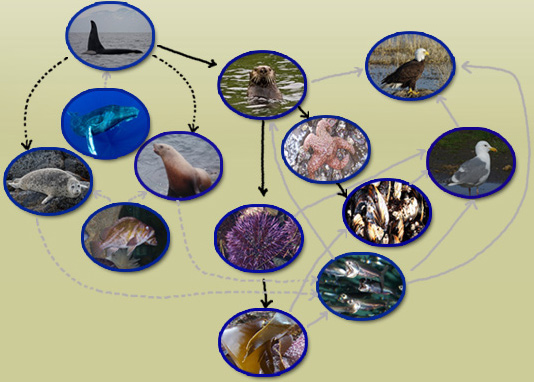Food Webs
Who eats whom in the marine world? To know why the Steller sea lion population is not recovering, scientists must understand the many connections in their food web. Food webs describe the food and energy relationships of organisms in a given place: who eats what or whom and who, in turn, feeds on them. The Life History Transmitter (LHX) helps scientists to begin to unravel the food web. The LHX can help answer whether or not young Steller sea lions are dying as a result of disease or starvation or may be eaten by predators such as killer whales or sharks.

Food Web Diagram (after Jim Estes et al., Phil. Trans. R. Soc. B (2009) 364, 1647–1658, doi: 10.1098 /rstb.2008.0231) The arrows represent linkages for which there are known (solid lines) or suspected (dashed lines) dynamic interactions. (Note: In this diagram the sea lion and killer whale linkage is suspected rather than known. The LHX data shows predation by killer whales is very likely happening.)
Most marine food webs involve transferring the energy from the sun that gets absorbed by plants, which provide food, to more and more complex animals. The ocean is highly dependent on plant life in the form of tiny floating plants called phytoplankton. These phytoplankton provide food for tiny floating ocean animals called zooplankton, which provide food for tiny fish, which are eaten by larger fish and so on to larger and larger animals. In the marine environment, all of these feeding actions are happening underwater in remote places where scientists cannot see them.
Steller sea lions are near the top of the food web. Their role in the food web is complex and involves many different organisms. Sharks, humans, and orcas prey upon Steller sea lions. Steller sea lions prey on many different fish species and even on squid and octopus. In many places, a substantial portion of their diet is composed of Atka mackerel and pollock. (Pollock is an ocean fish that humans catch in very large quantities for food.) Adult pollock eat krill and fish, including young pollock. Other fish, marine mammals, seabirds, and humans prey upon pollock. Young pollock eat copepods, microscopic crustaceans. Copepods, krill and fish feed on smaller microscopic floating plants. Those plants rely on ocean conditions that are controlled by climate, temperature, nutrients, light, and water mixing.
As each player in the food web eats something and is eaten, it controls the population of organisms who are dependent on it above and below itself in the food chain. To make matters even more complicated, each component in the food web is connected to another in multiple ways since organisms in rarely eat just one thing. Because so many organisms are connected in so many different ways, this is called a food web.
From initial results using the first and second generation of LHX tags, Dr. Horning and colleagues now believe a major source of mortality in juvenile Steller sea lions comes from predators that eat young sea lions, such as sharks and transient killer whales.